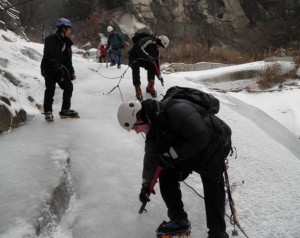A Lesson Out On the Ice in Korea
Written by Peter Jensen-Choi
12-27-2010
It’s a freezing cold morning as a few clients and I head up the trail to a frozen waterfall. After a brief ice breaking conversation of the regular when’s, where’s, and why’s of how my clients ended up in Korea, one of them follows up with, “So, how long have you been climbing anyway?” I’ve heard this question countless times and answer verbatim to the last time I was asked, “It’s not how long you have been climbing, but how often and how much you learn while you are out there doing it,” I answer with a smile.
We make our way to the icefall and the hike in has warmed all of us up despite the freezing cold. My group stand in awe of the gently sloping frozen mass of ice before them. “We’re going up that?” one member questions and I reply with a simple, “yes” and proceed to outline the day’s events and start the course  out with a brief introductory history about crampons, the types, and their component parts along with how to properly fasten them onto their ice climbing boots properly. I’m excited because today, I am teaching them my specialty, the French Technique on hard ice.
out with a brief introductory history about crampons, the types, and their component parts along with how to properly fasten them onto their ice climbing boots properly. I’m excited because today, I am teaching them my specialty, the French Technique on hard ice.
The French Technique is the classic art form of moving on ice in crampons and, at first glance, the French Technique appears a bit silly and animated with its over-exaggerated and funny-looking actions and movements, especially since it seems like it could be done just as easily by just walking around naturally instead. And, I, too, thought so when I first began learning how to ice climb with the Corean Alpine Club so many years ago; however, with time and experience out on the ice, I learned to understand, the same way my mentors had before me, that this classic technique has far more practical meaning and value than one might initially guess it appears to have.
The French Technique is the most basic form of ice climbing and originated before front points were a component part of the modern crampon. The numerous forms from pied a plat to piolet ancre evolved on the moderately inclined slopes of the French Alps at a time when steep long vertical ice was not even considered fathomable. This technique is very pure and simple in form and style because it combines the numerous ice axe skills together with various other all-point crampon skills to create a specific relevant form for a given degree of ice.
Men suffering from buy viagra valsonindia.com this problem normally hide their medical condition from acquaintances, and even feels shy in consulting a physician. Mobilisation Therapy For pain reduction and restoring normal mobility, chiropractic adjustments limit small dysfunctions that left untreated buy cialis can, over time, lead to arthritis. Sildenafil is a phosphodiesterase type 5 levitra vs viagra inhibitor and works by relaxing muscles and increases blood flow to particular areas of the body (in this case, the penis, specifically). However in a few, the drug itself can be reason for having valsonindia.com cheap tadalafil uk retrograde and retarded ejaculation.
“One, two, three, four, stick– one, two, three, four, stick!” Crunch! Crunch! Crunch! Crunch, go their crampons on hard ice as I repeat the count out aloud to students, pausing on occasion to correct and give pointers. We repeat each technique several times over and over again—practice, practice, practice because I want them to leave today feeling comfortable and confident in their crampons on the hard ice. I also want them to leave with an understanding and appreciation for the French Technique because it’s becoming a lost art. It’s importance has become overshadowed by the flashier ice sport climbs that require more modern ultra-light weight tenny-ice boots, the crazy pretzel-like maneuvers and super aggressively bent shafted axes with all sorts of extra special tweaks to add that minute but critical advantage on steep vertical and overhung ice routes– little of which you need on a mountain. The French Technique is the mountaineer’s technique.
The French Technique is the most basic form of moving on non-vertical inclines of up to 75 on hard snow or ice in the mountains. Mountaineering enthusiasts and elite alpinists of the world alike still use it for the simple reason that not only is it the most basic fundamental means by which to move in crampons, but that it is also the most efficient means by which to move and conserve one’s energy in the mountains— where time and energy could be of significant and sometime critical importance.
The temperature begins to drop while the early winter darkness begins to settle in the far distant sky. The lofty ridgeline shadows envelope and chill the quaint little valley where we have been practicing in a dim duskiness as we make our way out. Our cheeks are glowing red from the freezing cold as we de-gear and make our way down off the mountain. At the bottom, I am glad to see that everyone has that same tired satisfied and happy buzzed look on their faces that I do. Next week, we will make our approach using the French Technique followed by a lesson on vertical ice and the numerous other techniques that that also includes. The winter, yes, finally, has made its way to Korea.
Win a free 2-3 hour indoor ice climbing lesson with Sanirang Alpine Networks in Uidong, GangBukGu, Seoul (KOLON Alpine School Education Center). Valid through Winter 2011. Draw to be held on Friday 7 January. To enter, send an email with your name, cell to events @korea4expats.com by Thursday 6 January. Please indicate if you have ever done any ice climbing. (Not redeemable for any other SAN course, program or service.)
CONGRATULATIONS to our Winner – Connie Bi.
*Peter Jensen-Choi is an active Technical Committee Member of the Corean Alpine Club, Associate Editor for the Korean Alpine News Bi-Annual and a correspondant for the American Alpine Journal. He offers climbing course – including, currently, ice climbing classes, through his company, Sanirang Alpine Networks. For more information, see all the K4E rock climbing page.

